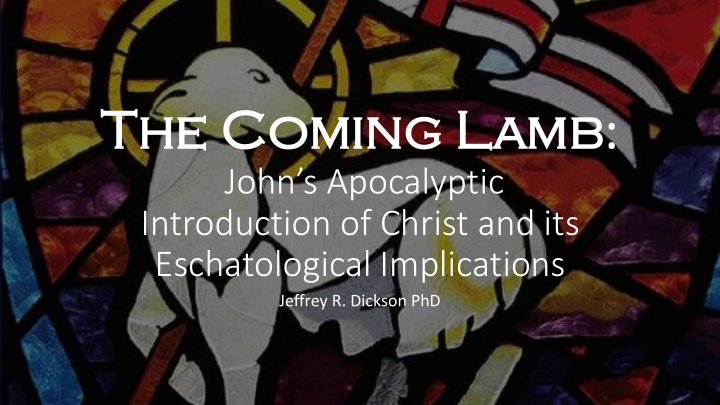



The he Coming Coming L Lamb mb : John’s Apocalyptic Introduction of Christ and its Eschatological Implications Jeffrey R. Dickson PhD
What if John used a word 29 times in Revelation for Christ? What if this proved to be more than double the number of any other title ascribed to Christ in the book? What if this oft-repeated term was used no where else in the New Testament in reference to Jesus? What if this term is introduced in a most pivotal and climactic literary moment?
What if, in spite of this, appreciation for and study of these peculiarities has been largely ignored?
What if t those few studies devoted to these phenomena reach ched u unnaturally u univocal i interpretations?
What if I stopped asking questions and finally get to my argument?
Answers to all of these questions (minus the last one) concern a single word: ἀρνίον ( arnion ) After perusing several incomplete interpretive options for ἀρνίον , this argument will reach a responsibly robust interpretation of John’s humble and glorious Lamb as witnessed in his apocalyptic introduction by means of a contextual-grammatical-canonical- historical hermeneutic that is focused on the authorial intent and what is reflected in the text of Revelation.
ἀμνὸς ( amnos ) πάσχα ( pascha ) Lambs that were available to John for use in Revelation: ἀρήν ( arein )
ἀρνίον ( arnion ) What is up with this?
Possi ssible R Referents: ts:
What follows is a contextual- grammatical-canonical-historical approach to interpreting the Lamb of Revelation, particularly as he emerges in Revelation 5:6-10.
• In the verses leading up to 5:6–10, there is a great deal of potential literary energy that when released successfully instigates the judgments that are unleashed upon the earth through the seals, trumpets, and bowls. • However, the worship that is expressed by the heavenly inhabitants of these two chapters is Contextual Co temporarily interrupted by a scene that breaks out in the beginning of chapter 5. Analy lysis is: • John weeps as a problem is presented with no Revelation 5:6-10 apparent solution. • A hero exists that has provided salvation and as a direct result is qualified to provide salvation for John’s present distress (opening the seven-sealed scroll and paving the way for the eschatological judgment and salvation to be disclosed in the remainder of the Apocalypse).
Diagrammatical A Analysis: Revelation 5:6-10 • Much of what this passage has to say is contingent on understanding ἀρνίον . • John appears to be intentionally highlighting the antithetical nature of two images—Lion and Lamb—and their connection to one figure who embodies the connotations of both. • In one breath, John depicts the Lamb as slain and in the next he assigns images of dominion and rule to this humble figure.
• Jesus’ has a unique ability to set in motion the eschaton and thereby the ultimate salvation (glorification) of his people. • This ability is afforded him because he (the Lion of the Tribe of Judah) humiliated himself to the point of death (a Lamb standing as if slain) and as such has been given all power (seven horns) and Tent ntative perception (seven eyes), to continue to perform God’s will. Interpretation: • Because of this, he is worthy of worship. Revelation 5:6-10 • The christological statement made here (accentuated by the image of the ἀρνίον ) successfully portrays Jesus in his humblest and therefore most glorious light (His passion). This symbol affords Christ equal status with God, the praise of all present in this heavenly spectacle, and the kind of literary capacity necessary to house many other Christological themes within its domain.
Canonical and Historical Analysis • Is there Precedence in Johannine Literature? • Is there Precedence in the New Testament? • Is there Precedence in the Old Testament? • Is there Precedence in Extra-Biblical Literature?
• In Revelation 5:6–10, Jesus is cast as a brilliant paradox that accentuates not only his matchless glory but his uncompromising humility. • The words used (particularly ἀρνίον ), descriptions offered (seven horns and seven eyes), worship witnessed, precedent given (in both the Old and NTs), and even the extra-biblical usage of the same term support these claims. Concl clusion ons • By employing a peculiar term in this midst of his opening description of Christ, John allows himself the literary freedom to accomplish his goal of describing a humble and therefore glorious God- Man that he calls to mind no less than 28 additional times throughout the remainder of this letter in a variety of contexts to communicate a robust Christology.
• The Lamb who is worthy of worship Chris istolo logic ical l • The Lamb who is Judge Implic licatio ions: : • The Lamb who leads (as shepherd, general, and host) • The Lamb of heaven
For a complete analysis and greater historical survey of the interpretation of the lamb Christology of Revelation, see The Humility and Glory of the Lamb: Toward a Robust Apocalyptic Christology Wipf & Stock, 2018 By Jeffrey R. Dickson PhD
Recommend
More recommend